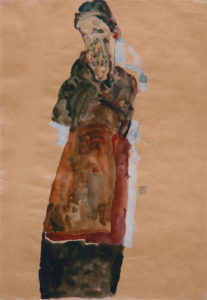“Degenerate” was a term used by the Nazis to describe most modern art. The Nazis were vocally opposed to many modernist styles and schools since their streetfighting days in the 1920s. They preferred strict realism that elevated German ideals and the classical, Greco-Roman human physique. However, it wasn’t until several years into Nazi rule that art regulation came into effect. In 1937, the Nazi government appointed Adolf Ziegler to head a commission to determine what works hanging in state-operated museums should be considered degenerate. The work’s style was not the only determining factor in this matter. Regardless of style, any work created by Jewish, Black, or leftist artists was likewise deemed degenerate by the Nazis and purged from museums across Germany. The goal was to assemble all these works and put them on display in an exhibition in Munich that would “educate” the public about degeneracy in the arts and how to avoid it. Records indicate that the government seized over 15,000 works of art from around a hundred museums across the country, with some of the most targeted artists being German expressionists like Max Beckman, Erich Heckel, Ernst Ludwig Kitchener, and Emil Nolde. They also confiscated works by other modern masters like Max Ernst, Paul Klee, Max Pechstein, Jean Metzinger, Piet Mondrian, and Wassily Kandinsky. Despite the Nazi’s claim of Jewish influence on modern art, very few “degenerate” artists were Jewish. Marc Chagall was one of the only Jewish artists of note who had their work displayed in the exhibition. Beyond this initial Munich exhibition, works by Picasso, Matisse, Miró, Dalí, Van Gogh, and Munch were later confiscated, destroyed, or sold abroad to fund German rearmament.
One of the artists targeted by the Nazis was Egon Schiele. A student of Gustav Klimt, Schiele was a sort of Austrian proto-Expressionist, known primarily for his nude paintings like Semi-nude with Green Stockings from the Back, The Embrace and The Family. At the time of his death in 1918, having succumbed to the Spanish flu at 28, Schiele’s work was already hanging in several German museums, most notably the Folkwang Museum in Essen. In 1918, the Folkwang housed the largest collection of Schiele’s work of any museum. These works were seized from the Folkwang, along with around 1,400 others. And the Folkwang’s attempts to reacquire these works have exposed one of the most significant untreated wounds inflicted by the Nazis. The Law on the Confiscation of Products of Degenerate Art, enacted on May 31, 1938, was never repealed after the fall of Nazism and remains in effect today. Therefore, the seizure of degenerate art was and remains, technically, totally legal and valid. There’s nothing German museums can do to regain their collections other than buy the works back. And that is exactly what the Folkwang has been doing. Standing Woman Covering Face with Both Hands, a 1911 Schiele watercolor and gouache on paper, is now the twenty-fifth work the Folkwang has purchased that it previously owned before 1938, which the museum has recently reacquired. Unfortunately, the museum could not buy the piece in time to join its expressionist exhibition that closed in January.
The Folkwang is far from the only museum that is taking this approach. For example, last year, Düssldorf’s Kunstpalast reacquired Still Life with Lilac and Anemone by Lovis Corinth. Since many German museums do not have robust endowments or large sections of their budgets dedicated to new acquisitions, they have to look for funds elsewhere. Many receive aid from private organizations to reacquire these works, most prominently the Ernst von Siemens Art Foundation. But despite the outside help, the museums’ efforts are not always successful. For example, in 2013, the Mannheim Kunsthalle attempted to buy back a drawing by Oskar Kokoschka when it came up at auction at Christie’s London. Unfortunately, the bidding surpassed what they were willing to put up, selling to an anonymous buyer for £265K w/p.
Museums like the Folkwang face enormous difficulty in reuniting lost works with the remainder of their collections. They have help from private groups but are often not the best equipped nor properly funded to achieve this goal. It’s stories like this that offer small bits of hope that, one day, that which was once stolen will be found again.

